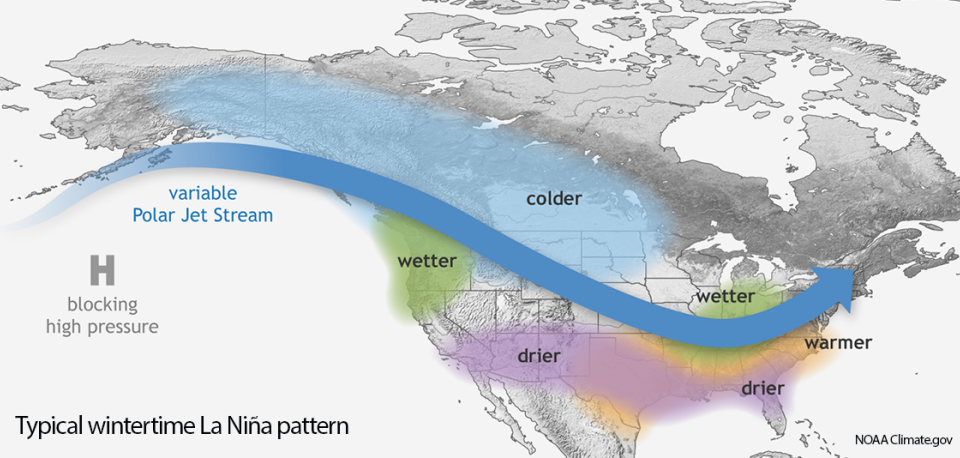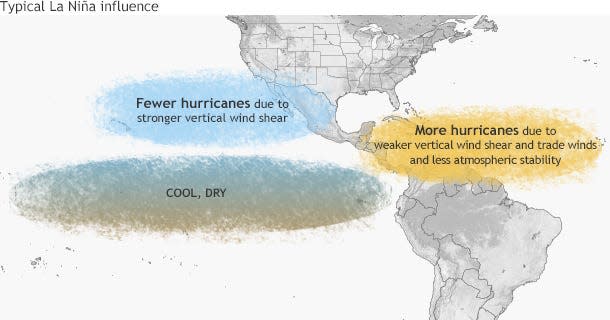What is La Ni?a? Does it bring more snow? How climate pattern could affect US weather.
So what exactly is La Ni?a?
The La Ni?a climate pattern is a natural cycle marked by cooler-than-average ocean water in the central Pacific Ocean. It is one of the main drivers of weather in the United States and around the world, especially during the late fall, winter and early spring.
It's the opposite to the more well-known El Ni?o, which occurs when Pacific ocean water is warmer than average.
Both are Spanish language terms: La Ni?a means "little girl," while El Ni?o means "little boy," or "Christ child." South American fishermen first noticed periods of unusually warm water in the Pacific Ocean in the 1600s, the National Oceanic and Atmospheric Administration said. The full name they used was "El Ni?o de Navidad" because El Ni?o typically peaks around December.
The entire natural climate cycle is officially known by climate scientists as El Ni?o – Southern Oscillation (ENSO), a see-saw dance of warmer and cooler seawater in the central Pacific Ocean.
During La Ni?a events, trade winds are even stronger than usual, pushing more warm water toward Asia, NOAA said. Off the west coast of the Americas, upwelling increases, bringing cold, nutrient-rich water to the surface.
These cold waters in the Pacific push the jet stream northward, which affects weather patterns in the U.S. and globally.
What is a La Ni?a winter?
A typical La Ni?a winter in the U.S. brings cold and snow to the Northwest and unusually dry conditions to most of the southern tier of the U.S., according to NOAA's Climate Prediction Center. The Southeast and Mid-Atlantic also tend to see warmer-than-average temperatures during a La Ni?a winter.
New England and the Upper Midwest into New York tend to see colder-than-average temperatures, the Weather Channel said.

Because La Ni?a shifts storm tracks, it often brings more snow to the Ohio and Tennessee valleys. "Typically La Ni?a is not a big snow year in the mid-Atlantic," said Mike Halpert, deputy director of the Climate Prediction Center. "You have a better chance up in New England."
Texas A&M University agricultural economist Bruce McCarl said La Ni?a years are often bad for agriculture in Texas and the surrounding region. U.S. production of most crops – except corn – generally goes down in La Ni?a years, according to research by McCarl.
Globally, La Ni?a often brings heavy rainfall to Indonesia, the Philippines, northern Australia and southern Africa.
What to expect: La Ni?a climate pattern should return this fall and last through winter. Here's what to expect.
During La Ni?a, waters off the Pacific coast are colder and contain more nutrients than usual. This environment supports more marine life and attracts more cold-water species, such as squid and salmon, to places like the California coast.
Can La Ni?a worsen the Atlantic hurricane season?
Yes, according to the Climate Prediction Center. “La Ni?a can contribute to an increase in Atlantic hurricane activity by weakening the wind shear over the Caribbean Sea and tropical Atlantic Basin, which enables storms to develop and intensify,” Halpert said in 2020.
Vertical wind shear refers to the change in wind speed and direction between roughly 5,000-35,000 feet above the ground, NOAA said. Strong vertical wind shear can rip a developing hurricane apart, or even prevent it from forming. This is what can happen in the Atlantic during an El Ni?o when Atlantic hurricane activity is often suppressed.
While La Ni?a tends to increase hurricanes in the Atlantic, it also tends to decrease their numbers in the eastern and central Pacific Ocean basins.

This article originally appeared on USA TODAY: What is La Ni?a? Does climate pattern bring more snow? We explain.
